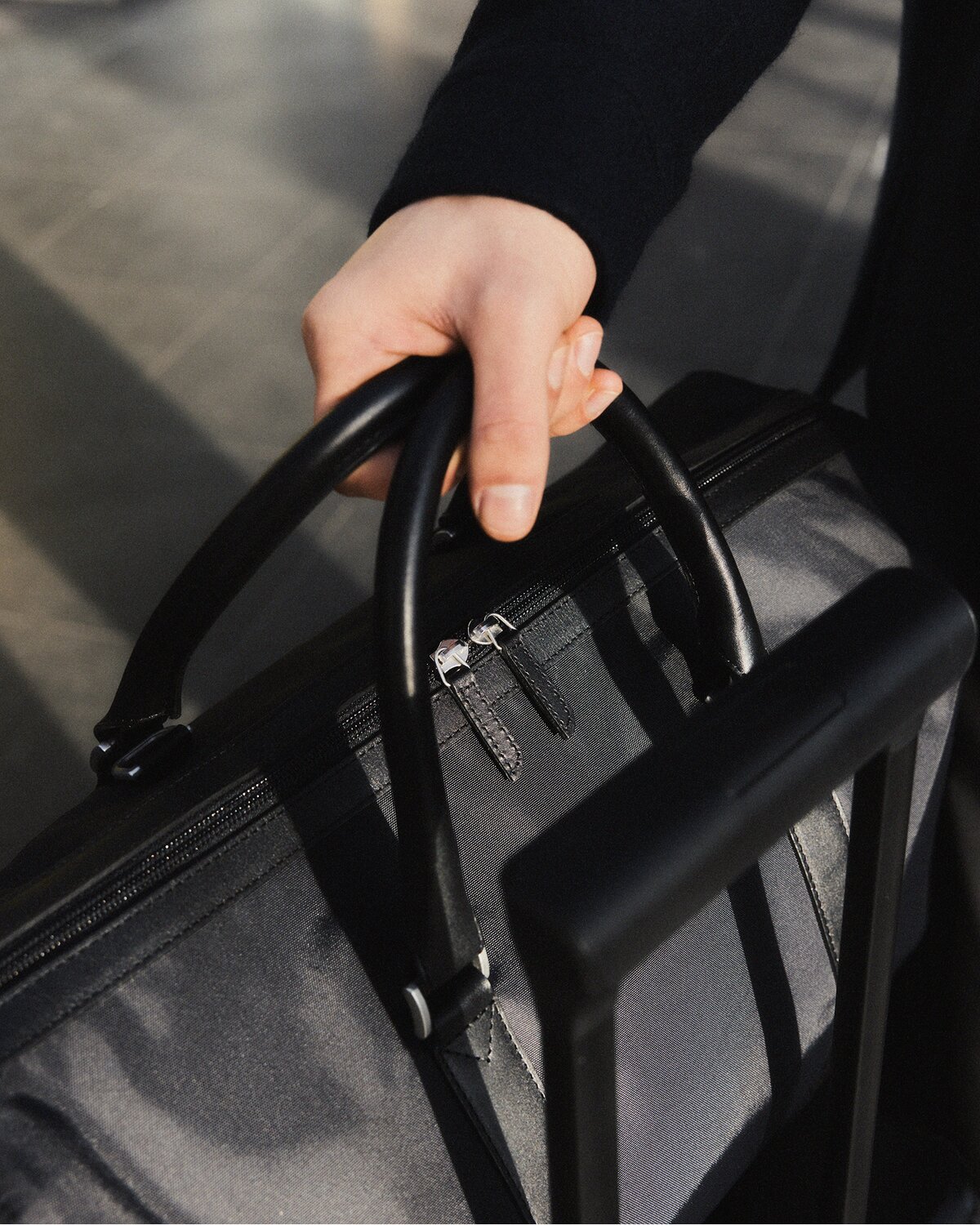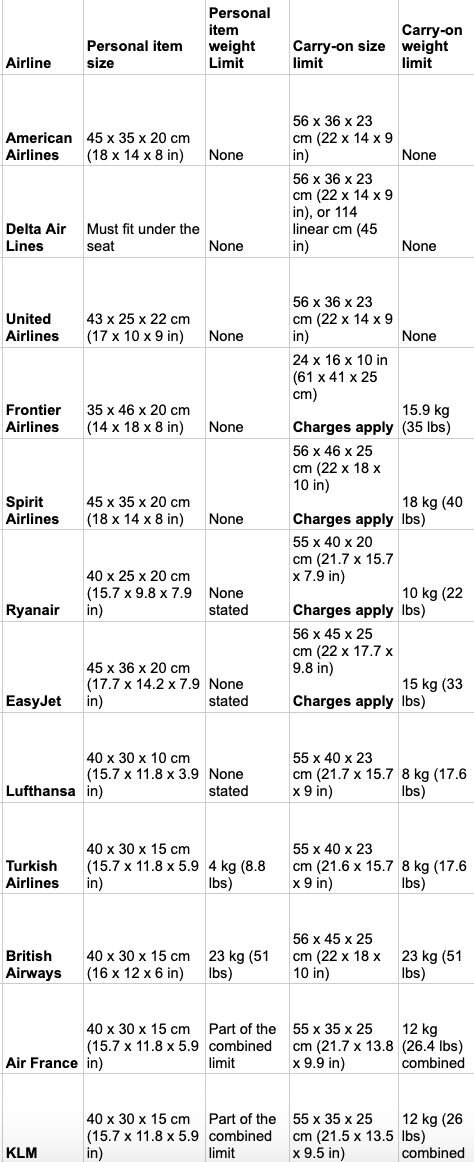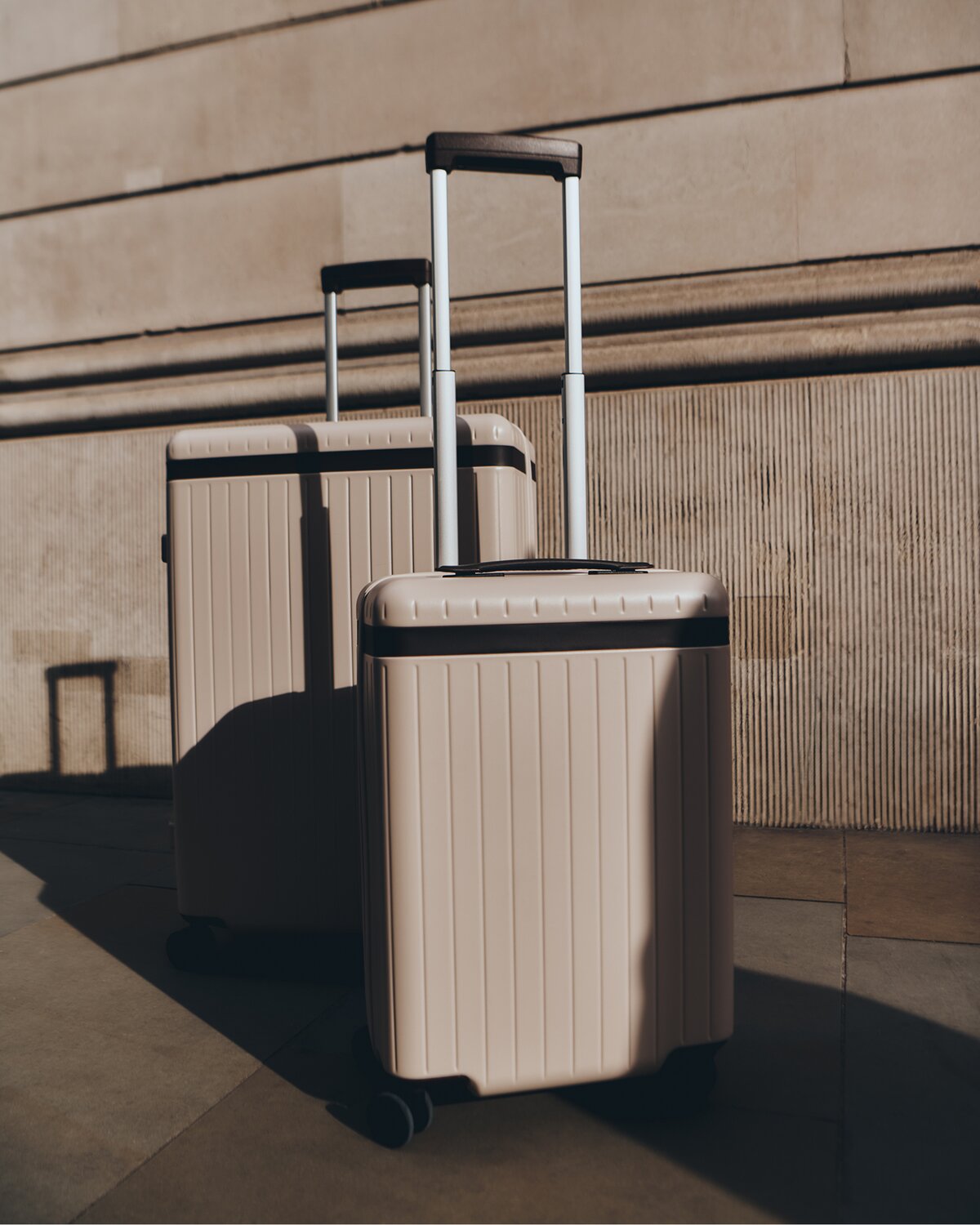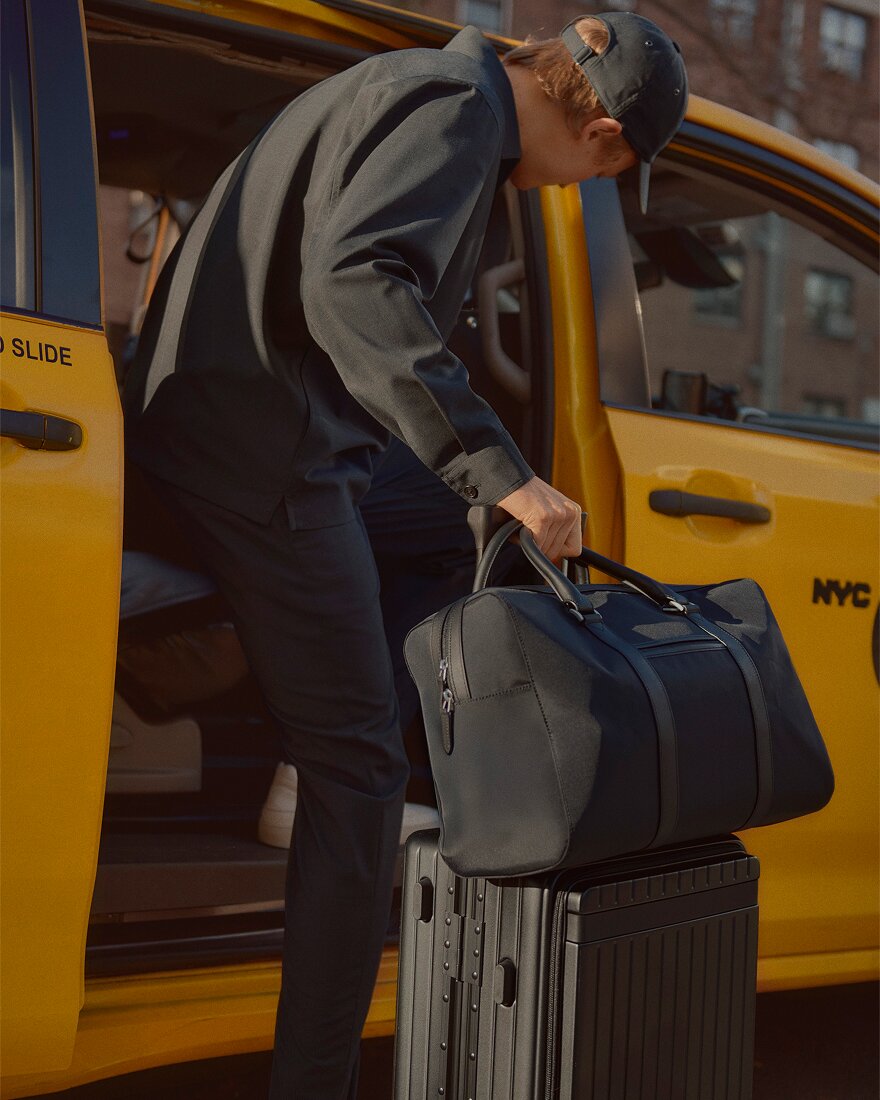But to travel effectively, you’ll also require an acute understanding of carry-on vs personal item rules.
This post covers key considerations and differing airline regulations. Read on to learn how never to pay exorbitant luggage fees or perform an awkward last-minute bag repack again.
Contents
What is a carry-on?
What is a personal item?
What is the difference between a carry-on and a personal item?
Airline policies on a personal item vs. carry-on
Choosing the right carry-on and personal item
Common mistakes when using a carry-on bag or personal item
Packing tips for a carry-on bag vs. a personal item
What is a carry-on?
Also known as cabin luggage, this is any bag you carry onto an aircraft and stow in the overhead compartment. Airlines don’t care whether you’ve got a backpack, suitcase, duffle bag or a tote. What they do worry about is size and weight.
A typical European carry-on bag size limit is 55 x 40 x 20 cm (22 x 14 x 9 inches), while weight limits range from 7 to 10 kg (15 to 22 pounds). Most US-based airlines don’t set carry-on weight limits and have similar size restrictions to their European counterparts.
However, these are just approximations. Every airline has unique size and weight limits, and it’s the passenger’s responsibility to learn them and comply.
Most airlines allow one carry-on bag with every fare sold. However, some low-cost carriers (Spirit, Frontier, Ryan Air, etc.) charge a carry-on luggage fee. Others let you increase your total carry-on weight allowance through a small surcharge.
What is a personal item?
A personal item is any object you carry onboard in addition to (or instead of) a carry-on bag. While specific size limits apply, the rule of thumb is that a personal item must fit under the seat in front of you.
Again, airlines don’t mind if it’s a purse, camera, handbag or a small laptop backpack, so long as it squeezes beneath that tiny little seat. While size limits vary between carriers, a bag under 43 x 33 x 20 cm (17 x 13 x 8 inches) will generally be okay. Malleable, soft-shell luggage like backpacks can contort for a better fit.
Some carriers include the personal item weight in your total carry-on allowance; for example, you get a maximum of 22 pounds for both bags. Others don’t weigh personal items at all.
What is the difference between a carry-on and a personal item?
The main difference between a carry-on and personal item is that the former goes in the overhead compartment while the latter slides beneath the seat.
The two bags also differ in purpose. Seasoned travellers stow in-flight essentials in their personal item bag as it's always within arm’s reach. Carry-on luggage typically holds toiletries, clothing and other items you won’t need during the flight. Airlines tend to be more strict about weighing carry-on bags than personal items.
| Personal item | Carry-on luggage | |
|---|---|---|
| Typical size limit | 43 x 33 x 20 cm (17 x 13 x 8 inches) | 55 x 40 x 20 cm (22 x 14 x 9 inches) |
| Typical weight limits | Included in the total carry-on weight limit or not weighed at all | 7-10 kg (15-22 lbs), varies by airline |
| Stow location | Under the seat in front of you | Overhead bin |
| Common bag types | Small backpack, tote, laptop bag, small handbag | Small suitcase, duffel bag, roller bag, weekend bag |
| Typical contents | In-flight essentials like passports, electronic gadgets and medication | Clothes, shoes and larger personal belongings |
| Airline Enforcement | Usually pretty lenient | More strictly monitored, especially for larger bags |
Airline policies on a personal item vs. carry-on
This handy cheat sheet outlines the carry-on and personal item policies of most major US and European airlines. Note that size restrictions include handles and wheels.
- Disclaimer: We’ve confirmed all these regulations are up-to-date as of May 2025. However, airlines alter policies all the time; review the rules via their official website.
Baggage policy
American Airlines carry-on and personal item policy
Delta carry-on and personal item policy
United Airlines carry-on and personal item policy
Frontier Airlines carry-on and personal item policy
Spirit Airlines carry-on and personal item policy
RyanAir carry-on and personal item policy
EasyJet carry-on and personal item policy
Lufthansa carry-on and personal item policy
Turkish Airlines carry-on and personal item policy
British Airways carry-on and personal item policy
We’ve based this table on economy class. Premium economy and business passengers can expect more generous allowances.
Choosing the right carry-on and personal item
Now you understand the intricacies of the carry-on and personal item. So, what bags should you get for your global escapades?
Our popular carry-on range balances timeless style with airport-ready functionality for an elegant yet easy aviation experience. Coming in a range of colours, these refined polycarbonate suitcases feature 360-degree spinner wheels, any-stop trolley systems and premium leather detailing.
For quick leisure trips, our range of weekenders offer a slick alternative to the classic hardshell suitcase. Spacious interior pockets, intricate detailing and stylish shoulder straps assure functionality and aesthetics. Ranging from 24 to 35 litres, they’re perfect for two or three days away.
Looking for a sleek personal item to stash under the seat? Our smaller all-leather backpacks and tote bags fit the bill. Business travellers hopping between conferences might prefer the classic aesthetics of a premium leather briefcase instead.
Common mistakes when using a carry-on bag or personal item
Learning the classic carry-on bag vs. personal item blunders puts you in a good position to avoid them.
- Using oversized bags: Learn the rules and measure your carry-on and personal item before leaving home. Otherwise, you risk a nasty surcharge should it not fit in the airport baggage sizer
- Taking overweight bags: Research restrictions and weigh your bags with a digital scale. Ground staff will regularly gate-check passengers with larger-looking carry-ons
- Not considering the personal item: While some US airlines don’t set personal item weight limits, others count the pounds towards your total limit and strictly enforce their rules
- Bringing two carry-ons: Most economy class fares only allow one carry-on bag. Taking two means you’ll have to check one in and pay exorbitant last-minute fees
Packing tips for a carry-on bag vs. a personal item
Ensure all your in-flight essentials — entertainment, sleeping pills, earplugs, moisturiser, warm clothes — reside within your personal item. You don’t want to wake your seatmate and rummage through the overhead cabin to grab a sweater at 3 am.
When packing a carry-on, include anything you won’t need during the flight, such as clothes, toiletries and non-essential medicines. You’ll still have access, albeit with more effort.
Cabin luggage restrictions apply to both carry-on and personal items. Leave the following at home or put them in a check-in bag.
- Sharp objects
- Explosive or flammable materials
- Hazardous or poisonous materials
- Larger batteries and power banks over 100 Wh
- Liquids, aerosols and gels, unless in containers smaller than 100ml
Is a backpack considered a personal item or carry-on?
Can I bring 2 personal items instead of a carry-on?
Can I bring a carry-on and personal item on every airline?
What counts as a personal item vs. a carry-on bag for international flights?
Can a carry-on vs. personal item be the same size?
The latest product news and travel guides? It's just a sign-up away.









